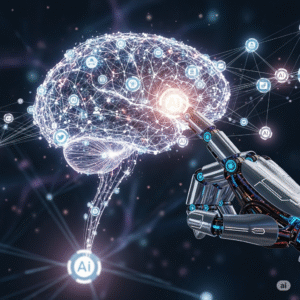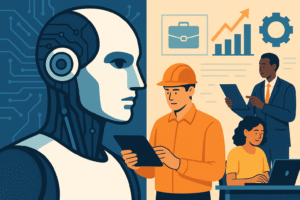The landscape of pharmaceutical research and development is undergoing a profound transformation, driven by the exponential advancements in artificial intelligence (AI). From identifying potential drug targets to predicting clinical trial outcomes, AI drug discovery is no longer a futuristic concept but a tangible reality reshaping how new medicines are brought to patients. The intricate and often protracted process of traditional drug discovery, fraught with high costs and significant attrition rates, is finding a powerful ally in AI, promising to accelerate timelines, reduce expenses, and ultimately, lead to the development of more effective therapies for a wide range of diseases.
The integration of AI into pharmaceutical research spans numerous critical stages, each offering unique opportunities to enhance efficiency and innovation. One of the earliest and most impactful applications lies in target identification and validation. Traditionally, scientists spent countless hours analyzing vast amounts of biological data to pinpoint promising molecular targets for drug intervention. AI algorithms, particularly those leveraging machine learning and deep learning, can sift through this complex data with remarkable speed and accuracy. By analyzing genomic, proteomic, and transcriptomic data, AI can identify novel drug targets, predict their relevance to specific diseases, and even elucidate the underlying biological mechanisms. This targeted approach significantly increases the chances of developing drugs that are more likely to succeed in later stages of development.
AI drug discovery
Beyond target identification, AI plays a crucial role in drug design and optimization. Once a target is identified, researchers need to discover or design molecules that can effectively interact with it. This involves exploring a vast chemical space, a task that is both time-consuming and resource-intensive using conventional methods. AI-powered platforms can simulate the interactions between potential drug molecules and their targets, predicting their binding affinity, selectivity, and potential toxicity. This in silico screening allows researchers to prioritize the most promising candidates, reducing the need for extensive and costly laboratory experiments. Furthermore, AI algorithms can be used to optimize the properties of lead compounds, improving their efficacy, safety, and pharmacokinetic profiles.
The application of AI extends to the challenging phase of clinical trials as well. Predicting patient responses to drugs and optimizing trial design are critical for the success of clinical development. AI algorithms can analyze historical clinical trial data, patient demographics, and even genetic information to identify patient subgroups that are most likely to benefit from a particular treatment. This allows for more targeted patient selection, increasing the power of clinical trials and potentially reducing the number of participants needed. Moreover, AI can assist in real-time monitoring of trial data, identifying potential safety signals or efficacy trends early on, allowing for timely adjustments and informed decision-making. The ability of AI drug discovery tools to analyze complex datasets from clinical trials can significantly improve the efficiency and success rates of this crucial stage.
Real-World Impact: Case Studies in AI Pharmaceutical Research
To illustrate the transformative power of AI drug discovery, let’s examine a couple of real-world examples:
Case Study 1: Atomwise and the Ebola Virus
In the midst of the Ebola outbreak in 2015, the traditional drug discovery process faced an urgent need for rapid solutions. Atomwise, an AI-driven pharmaceutical company, utilized its deep learning platform to screen millions of existing compounds for potential activity against the Ebola virus. Their AI algorithms predicted that two existing drugs, previously approved for other conditions, had a high probability of binding to a key Ebola protein. Within a single day, Atomwise identified these potential candidates, and subsequent laboratory testing confirmed their inhibitory activity against the virus. This rapid identification of potential treatments in a crisis scenario highlights the speed and efficiency that AI drug discovery can offer.
Case Study 2: BenevolentAI and Amyotrophic Lateral Sclerosis (ALS)
BenevolentAI, another prominent player in the AI drug discovery space, focuses on using AI to understand the underlying mechanisms of diseases and identify novel therapeutic targets. In their work on Amyotrophic Lateral Sclerosis (ALS), a debilitating neurodegenerative disease, BenevolentAI’s platform analyzed vast amounts of scientific literature, clinical data, and genetic information. This analysis led to the identification of a novel target and a potential drug candidate that was already in clinical development for another indication. By repurposing an existing drug based on AI-driven insights into the disease’s biology, BenevolentAI significantly accelerated the timeline for potential treatment development for ALS patients. These examples underscore the tangible impact of AI drug discovery in addressing critical healthcare challenges.
Beginner’s Guide: Leveraging AI for Pharmaceutical Data Analysis
For researchers and organizations looking to incorporate AI into their pharmaceutical research workflows, several user-friendly tools and platforms are available. While advanced machine learning often requires specialized expertise, many platforms offer intuitive interfaces and pre-built models that can be readily applied to various drug discovery tasks.
Here are a few examples of AI-powered tools:
- Tableau: (https://www.tableau.com/) A powerful data visualization and analytics platform that can help researchers explore and understand complex biological and clinical datasets. While not specifically a dedicated AI drug discovery tool, its analytical capabilities are crucial for extracting insights from data that can inform AI-driven models.
- ChatGPT (OpenAI): (https://openai.com/chatgpt) While primarily a language model, ChatGPT can be a valuable tool for researchers in summarizing scientific literature, brainstorming hypotheses, and even assisting in the generation of research proposals. Its ability to process and synthesize large amounts of text data can indirectly support AI drug discovery efforts by accelerating information retrieval and knowledge synthesis.
- MonkeyLearn: (https://monkeylearn.com/) A platform focused on text analysis using machine learning. It can be used to extract key information from research papers, clinical trial reports, and patient feedback, providing valuable data for AI drug discovery pipelines.
- Power BI (Microsoft): (https://powerbi.microsoft.com/) Similar to Tableau, Power BI offers robust data visualization and business intelligence capabilities. It can be used to analyze various types of pharmaceutical data, helping researchers identify trends and patterns that can inform drug discovery strategies.
Tips for Implementing AI in Pharmaceutical Research:
- Start with a clear problem: Identify specific bottlenecks or challenges in your research process where AI could offer a solution.
- Focus on data quality: AI algorithms are only as good as the data they are trained on. Ensure your datasets are clean, well-annotated, and relevant to your research question.
- Collaborate with AI experts: Partner with data scientists and AI specialists who can help you design, implement, and interpret AI-powered analyses.
- Iterate and experiment: AI implementation is often an iterative process. Be prepared to experiment with different algorithms and approaches to find what works best for your specific needs.
- Stay updated on the latest advancements: The field of AI is rapidly evolving. Continuously learning about new tools and techniques is crucial for maximizing the potential of AI drug discovery.
The Future of AI in Pharmaceutical Research
The trajectory of AI drug discovery points towards an increasingly integrated and impactful role in pharmaceutical research. As AI algorithms become more sophisticated and access to high-quality data grows, we can expect to see even greater acceleration in the identification of novel drug targets, the design of more effective therapeutics, and the optimization of clinical development processes. The convergence of AI with other cutting-edge technologies, such as genomics and high-throughput screening, holds immense promise for unlocking new frontiers in medicine and addressing previously intractable diseases. Ultimately, AI drug discovery has the potential to revolutionize the pharmaceutical industry, leading to the development of innovative and life-saving treatments for patients around the globe. The continued advancement and adoption of AI drug discovery methodologies will be critical in shaping the future of healthcare.
AI for teachers: AI Tools for Lesson Planning and Assessment



